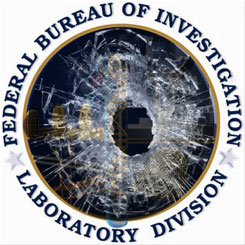ELEMENTARY,
MY DEAR WATSON:
The Forensic Examination of Glass
12/22/04
 Remember that
old "minute mystery" about poor Jack and Jill, their
bodies discovered in the library with only broken glass and a pool of
water left behind as evidence of the crime?
Remember that
old "minute mystery" about poor Jack and Jill, their
bodies discovered in the library with only broken glass and a pool of
water left behind as evidence of the crime?
We're happy to
tell you that Everything You Ever Wanted To Know about
the forensic examination of glass is now available
in this month's issue of Forensic
Science Communications--68 pages
worth.
So put on your Crime
Scene Investigation hat and pick up some of that broken glass next to Jack
and Jill to figure out whodunit.
1. Review
definitions and map out a plan of analysis.
This gives you basic definitions (e.g., glass is an
inorganic product of fusion that has cooled to a rigid
condition without crystallizing) and suggests you
use a variety of analytical methods (see below) to
yield a maximum of different kinds of information.
2. Collect,
handle, and identify the evidence. Here
you learn how to retrieve/collect the evidence from
the floor (and possibly from the clothing of Jack
and Jill's murderer)...how to select samples and how
to clean and analyze them.
3. Make
your initial examination. If possible,
you'll want to determine the color, fluorescence,
surface features, curvature, and thickness of the
glass.
4. What
about fractures? Are they radial or concentric?
Crater or hackle? A fracture match is an absolute
means of identification.
5. Now
measure the density of the sample. Density
tells you something about the composition and thermal
history of the glass, telling you if you've got different
sources of glass in the sample. You need a relatively
large piece of glass for this test.
6. Can
you measure the refractive index of the evidence?
Refractive index is the most commonly measured
property in forensic glass analysis. It can tell you
the same sorts of things as density, but you only
need a very small piece of glass. Testing both density
and refractive index tells you more than just checking
one or the other.
7. Now
let's determine major, minor, and trace elements in
the glass, even though it can destroy
the sample. So be sure you've finished all the nondestructive
exams first...and satisfied any legal considerations
for an upcoming trial. Your choice: you can use scanning
electron microscopy-energy dispersive X-ray spectrometry...X-ray
fluorescence spectrometry...inductively coupled plasma-optimal
emission spectrophotometery...inductively coupled
plasma-mass spectrometry...laser ablation-inductively
coupled plasma-mass spectrometry,,,or even atomic
absorption spectrophotometery. The good and bad points
of each are outlined.
The upshot:
all fingers point to the butler! He was dusting when he knocked
the fish bowl off the library table. Poor Jack and Jill.
Links: FBI
Laboratory


